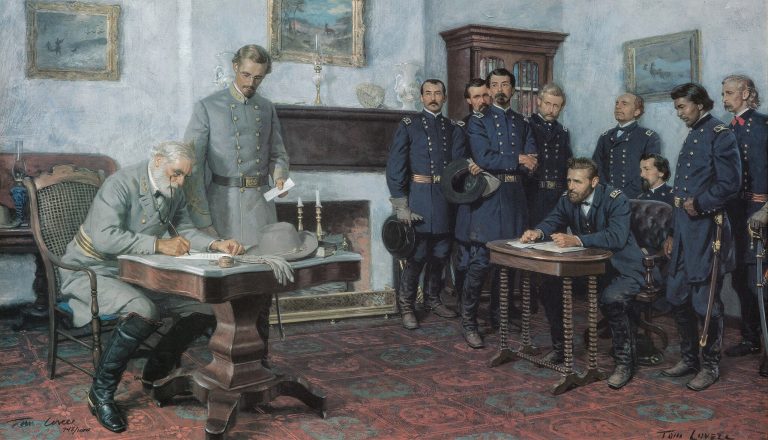
Painting: Surrender at Appomattox by Tom Lovell, commissioned in 1964 by National Geographic Society. Left, General Lee, Right, General Grant, et el.
Washington, D.C. Artist Tom Lovell was considered one of the finest living historic illustrators in 1964 when commissioned by the National Geographic Society to create a painting of a very important event to be used in an article reflecting on its 100th anniversary. The date, April 9, 1865, marked the end of the Civil War with the signing and surrender in a living room in the village of Appomattox Courthouse, Virginia.
National Geographic realized no such visual record existed of such an important event in our nation’s history. Lovell was given open access to all written accounts, documents and photographs of those in attendance and access to the location for his meticulous research. This painting “Surrender at Appomattox” has since become accepted as the most authoritative depiction of the event.
Lovell was a perfectionist and clearly the finest choice to create a painting depicting the emotion of the moment.
Gen. Ulysses S. Grant, head of the Union forces, in his soiled uniform, with no spurs or saber, sits slump shouldered and tired, truly humble as the significance of the event sets in while observing Gen. Robert E. Lee, head of the Confederacy, dressed in his last best embroidered uniform with polished boots and spurs signing the terms of surrender.
Grant, clearly, along with his significant union observers, are heeding Lincoln’s words to allow Lee and the Confederacy very respectful and dignified terms of surrender to unify the country and become a nation.
Paintings created during the Civil War by noted artists such as Winslow Homer (1836-1910), Eastman Johnson (1824-1906), Thomas Moran (1832-1926), John Ross Key (1837-1920), William Aiken Walker (1838-1921) and others, are works reflecting daily life during the times and today are highly regarded as incredible fine art records of the period. Although there were cameras being used throughout the Civil War, ironically there were none present at the surrender at Appomattox nor was there an artist in attendance.
There are plenty of written accounts though, documenting virtually every detail of the historic event. The magnitude of the signing and surrender was so significant to the witnessing Union officers they virtually stripped the room bare of all furnishings after Lee’s departure and later troops cut strips of fabric from the couch and the carpet to own some record of the event which they would reflect on the rest of their lives.